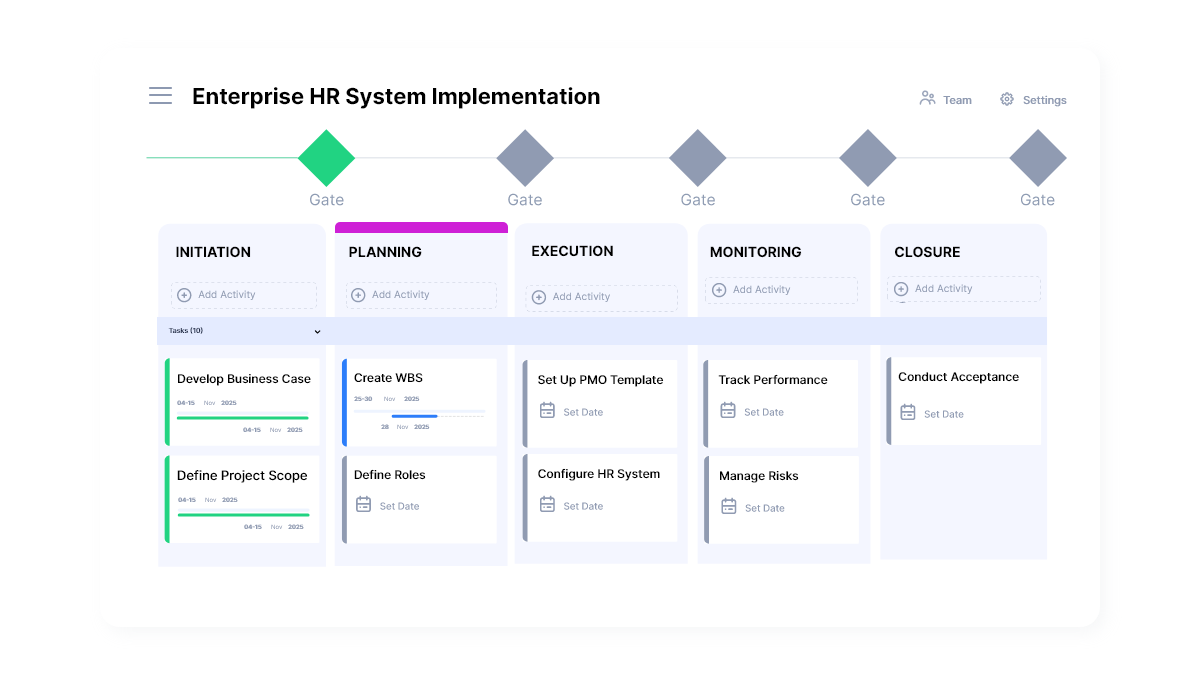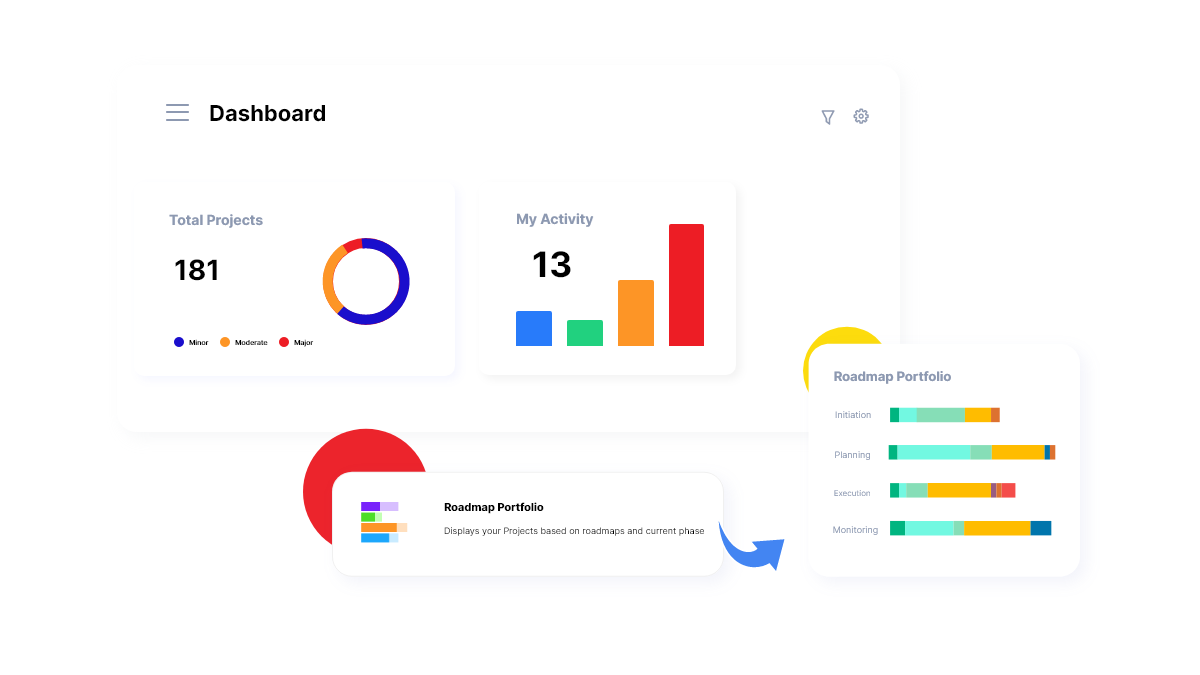
Ask any IT PMO leader what keeps them up at night, and the answers are strikingly similar: too many moving parts, too little visibility, and a constant struggle to keep projects aligned with business goals. The irony is that PMOs were created to bring structure and oversight, yet many are still buried under manual approvals, siloed tools, and endless status updates.
The turning point comes when an IT PMO stops relying on patchwork processes and starts working with smarter workflows. These workflows don’t just tidy up operations, they create a level of clarity and control that allows PMO leaders to anticipate risks, optimize resources, and make decisions grounded in real-time insight.
This shift is more than efficiency. It’s the difference between managing projects and driving measurable impact across the enterprise.
Why Clarity and Control Define IT PMO Success
For an IT Project Management Office (IT PMO), the mandate is clear: deliver governance, optimize resources, ensure compliance, and keep complex technology projects on track. Yet in reality, most IT PMOs operate under relentless pressure. They are expected to maintain order across portfolios that span everything from software development to infrastructure upgrades, often while navigating shifting priorities, limited budgets, and rising stakeholder expectations.
The challenge is not a lack of expertise. It is the weight of manual processes, fragmented tools, and a chronic lack of transparency. Status updates buried in spreadsheets, approvals lost in email threads, and resource bottlenecks that surface too late all create friction that drains momentum. Instead of acting as a strategic driver, many IT PMOs are left firefighting issues that smarter systems could have prevented.
This is where smarter workflows change the equation. They are not just another layer of technology. They are the connective tissue that allows IT PMOs to replace complexity with clarity, to shift from oversight to foresight, and to establish control that scales with the organization. By embracing smarter workflows, an IT PMO moves beyond administration into true transformation, guiding projects with precision while delivering measurable business value.
To bring this transformation into focus, McKinsey underscores that successful digital transformation hinges not just on deploying technology, but on rewiring organizational core processes for continuous value creation—aligning precisely with how smarter workflows elevate IT PMO performance.
 Reframing the IT PMO as a Strategic Backbone
Reframing the IT PMO as a Strategic Backbone
An Information Technology Project Management Office (IT PMO) is far more than a support function. It is the strategic backbone that ensures every technology initiative is not only delivered on time but also aligned with broader organizational goals. In a world where digital transformation defines competitiveness, the IT PMO has become the custodian of clarity, consistency, and control across complex project portfolios.
At its core, the IT PMO is tasked with governance and oversight. It establishes standardized project management practices, ensures compliance with frameworks, and monitors delivery against objectives. By creating a uniform structure, it reduces ambiguity and builds trust across leadership teams who need reliable insights before making critical decisions.
Equally important is resource optimization. The IT PMO is responsible for ensuring people, budgets, and technology assets are allocated intelligently. With visibility across multiple projects, it can balance competing demands, minimize wasted effort, and redirect resources to the initiatives that create the greatest business impact.
Another defining responsibility is transparency and accountability. The IT PMO provides a single source of truth through accessible documentation, progress reporting, and audit-ready records. This not only fosters accountability but also empowers leadership with the clarity to act decisively.
Finally, the IT PMO serves as the bridge that connects IT initiatives with business strategy. By aligning project outcomes with enterprise objectives, it ensures technology investments translate into measurable business value. This alignment transforms the IT PMO from a compliance checkpoint into a growth enabler that strengthens the organization’s competitive edge.
To fulfill these roles effectively, IT PMOs need more than spreadsheets and disconnected tools. They require systems that deliver control without bureaucracy — platforms that simplify oversight, automate manual work, and provide actionable insights. The modern IT PMO is not about creating layers of administration, but about enabling smarter, faster, and more strategic decision-making across the enterprise.
What Keeps IT PMOs from Delivering Full Value
An IT PMO is built to provide structure, discipline, and direction. Yet in practice, many find themselves constrained by the very processes meant to support them. Instead of acting as a strategic driver of clarity and performance, the PMO becomes weighed down by inefficiencies. Let’s break down the core challenges that stand in the way of progress.
Manual Processes That Drain Time
Despite being in the digital age, many IT PMOs still rely on manual approvals, spreadsheets, or email chains to move projects forward. These paper-based processes slow execution, increase the likelihood of errors, and create unnecessary administrative burdens. What should be a streamlined governance framework often turns into a tangle of bottlenecks.
Silos and Fragmented Tools
When project data lives across multiple applications, reports, or inboxes, teams operate in silos. This fragmentation prevents the IT PMO from gaining a clear, unified view of the portfolio. Disconnected tools make collaboration harder, duplicate efforts more common, and cross-functional alignment an ongoing struggle.
Limited Portfolio Visibility
For PMOs managing dozens of technology projects at once, visibility is everything. Yet without real-time dashboards or centralized tracking, leaders are left piecing together outdated updates from individual managers. This lack of portfolio visibility makes it difficult to identify risks, track dependencies, or provide executives with accurate progress reports.
Inefficient Resource Allocation
The role of the IT PMO includes balancing people, time, and technology investments. But without the right data and tools, resource allocation becomes reactive rather than strategic. Teams end up overextended, critical projects stall due to understaffing, and budgets are strained by inefficient use of available talent.
Reactive Risk Management
Perhaps the most significant challenge is the inability to anticipate issues before they escalate. Without predictive insights, PMOs are forced into firefighting mode, addressing problems only after they disrupt delivery. This reactive approach undermines confidence, increases project failure rates, and erodes the IT PMO’s role as a trusted partner in organizational growth.
 The Power of Smarter Workflows in IT PMOs
The Power of Smarter Workflows in IT PMOs
The modern IT PMO operates at the crossroads of governance, delivery, and strategy. Yet, without the right systems in place, it risks being reduced to a traffic cop of spreadsheets and status updates. Smarter workflows change the equation. They give IT PMOs the clarity, consistency, and foresight needed to move from reactive project oversight to proactive business leadership.
Below are the five ways workflow automation and intelligent process management elevate IT PMOs.
Unlock Centralized, Real-Time Visibility
At the heart of every IT PMO is the need for visibility. Without a clear view of what is happening across projects, small delays can spiral into costly setbacks. Smarter workflows provide unified dashboards and portfolio views that give leaders a live snapshot of progress, resource usage, and risks.
Instead of chasing updates through scattered emails or disconnected tools, PMOs gain real-time visibility into project health. Risks and bottlenecks can be identified instantly, enabling proactive intervention rather than reactive firefighting. This level of transparency builds trust with executives and stakeholders while ensuring that IT initiatives remain aligned with enterprise priorities.
Drive Efficiency Through Automation and Standardization
Manual approvals, repetitive status reports, and task assignments drain the energy of project teams and slow down delivery. Workflow automation removes that burden by digitizing routine activities and standardizing processes across the portfolio.
Every approval is logged, every handoff is tracked, and every report is generated without manual effort. By reducing inconsistencies and human error, automation ensures projects remain compliant and auditable. More importantly, teams are freed to focus on high-value activities like problem-solving, innovation, and stakeholder engagement, rather than administrative busywork.
Break Down Silos With Enhanced Collaboration
Most IT PMOs face one universal challenge: silos. When communication happens across too many disconnected channels, decisions lag and accountability fades. Smarter workflows address this by embedding collaboration directly into the workflow itself.
Built-in tools for communication, file sharing, and real-time updates keep everyone on the same page. Whether teams are distributed across geographies or functions, they can engage in the same context without switching between platforms. The result is faster decision-making, reduced delays, and a stronger sense of ownership across stakeholders.
Anticipate Risks Through Predictive Analytics
Traditional PMO reporting looks backward, summarizing what already happened. Smarter workflows look forward. By analyzing historical performance and identifying patterns, they deliver predictive insights that allow PMOs to anticipate risks before they escalate.
These predictive analytics highlight where bottlenecks are likely to occur, which projects may face delays, and where resources may fall short. Equipped with this foresight, IT PMOs can proactively reallocate capacity, adjust timelines, and mitigate risks early. This shift from reactive governance to proactive strategy elevates the PMO from an administrative function to a true business partner.
Optimize Resources for Strategic Impact
Balancing workloads across multiple initiatives is one of the most complex tasks for any IT PMO. Smarter workflows simplify this with dynamic resource allocation and capacity planning. Leaders can instantly see where skills are underutilized, where workloads are uneven, and where additional support is needed.
The outcome is a more efficient use of both people and technology. Projects are delivered faster and with fewer cost overruns, while teams avoid burnout from unsustainable workloads. By ensuring that talent and tools are applied where they create the most value, IT PMOs transform resource management into a strategic advantage.
 Planally in Action: A Smarter Path for IT PMOs
Planally in Action: A Smarter Path for IT PMOs
For IT PMOs, the challenge has always been the same: how to maintain clarity and control across multiple projects while reducing the drag of manual processes. Traditional approaches often leave teams buried in paper-based approvals, fragmented communication, and reporting cycles that move slower than the projects they are meant to guide. This is where smarter workflows shift the game, and where Planally equips IT PMOs to operate with precision, speed, and transparency.
Automating manual IT workflows is the first breakthrough. Routine tasks such as approvals, compliance checks, and endorsements no longer need to be delayed by email chains or paper trails. With Planally, these workflows are digitized and executed in real time, ensuring accuracy and freeing project teams to focus on initiatives that create measurable business value.
The second advantage comes from real-time visibility. Instead of chasing updates or reconciling scattered reports, IT PMOs can view the status of every workflow from request to completion in one centralized dashboard. This unified perspective enables leaders to spot bottlenecks, anticipate delays, and make decisions that keep projects aligned with strategic priorities.
Equally critical is collaboration. IT projects often involve multiple stakeholders across departments, and silos are a common source of friction. By embedding communication and file management directly into workflows, Planally eliminates the need to switch between tools. Conversations, documents, and approvals stay connected to the work itself, reducing delays and sharpening accountability.
With predictive, data-driven insights, Planally takes workflows beyond task management. Historical data and ongoing trends reveal patterns that help PMOs identify risks before they escalate. This continuous loop of insight and improvement gives IT leaders the foresight to adapt strategies early and avoid costly disruptions.
Finally, scalability ensures that IT PMOs can evolve without constraint. Planally’s no-code platform makes it easy to tailor workflows as business needs change. Whether scaling a single project or managing a portfolio across multiple departments, workflows adapt quickly without heavy reliance on IT resources.
By combining automation, visibility, collaboration, analytics, and scalability in one platform, Planally enables IT PMOs to transform the way they work. The result is not only greater efficiency but also a higher level of strategic control, ensuring IT projects deliver value that drives the enterprise forward.
From Complexity to Clarity: The Future of IT PMOs
In today’s fast-moving digital environment, IT PMOs sit at the intersection of technology and business strategy. They are tasked with aligning IT initiatives with organizational goals, ensuring that every project delivers measurable value. Yet the reality for most IT PMOs is one of constant pressure — navigating shifting priorities, fragmented tools, and a lack of visibility across portfolios.
This is where smarter workflows change the game. By unifying project oversight, automating repetitive steps, and embedding real-time visibility into every stage, smarter workflows create the control, consistency, and foresight IT PMOs need to deliver at scale. Instead of being reactive, teams gain the ability to anticipate risks, allocate resources strategically, and keep stakeholders aligned with confidence.
Planally takes this vision further. As a powerful workflow management platform, Planally equips IT PMOs with the clarity to lead and the agility to adapt. Complex, manual processes transform into streamlined, digital workflows that cut through bottlenecks and surface insights where they matter most. The result is a PMO that operates not as a bottleneck but as a catalyst, driving efficiency, strengthening compliance, and ensuring IT projects directly support business outcomes.
The path forward for IT PMOs is clear: move from complexity to clarity with smarter workflows that make every decision faster, every process more consistent, and every outcome more predictable. Planally is built to make that future a reality.
 One Platform for Every Workflow, Built for Control
One Platform for Every Workflow, Built for Control
The role of the IT PMO has never been more complex. Delivering on governance, resource allocation, compliance, and digital transformation requires more than oversight. It demands clarity, control, and workflows that can scale with the pace of business.
That is where Planally comes in. Planally is the no-code workflow management platform built for IT PMOs that need to move from manual, scattered processes to smarter workflows that create visibility, reduce risk, and accelerate delivery. With Planally, every approval, every resource, and every milestone is connected in one platform so your team can focus on outcomes instead of chasing updates.
If your IT PMO is ready to eliminate inefficiency, increase transparency, and gain control across the entire project portfolio, it is time to act.
Explore how Planally can simplify and scale your IT PMO workflows today at planally.com



